|
Different Methods of
Crab Culture
Pond Culture
Pond size of 0.5 to 1 acre is most suitable for crab culture. However, large size
ponds of more than one acre can also be used for this purpose. Sandy soils with
a mixture of 50% clay are ideal for culture of these crabs. A water inlet system
and an outlet system to drain out water during water exchange should be constructed
as in the case of shrimps. The pond should be constructed in such a way that it
should hold 3.5 to 4 feet of water towards the inlet and 4.5 to 5 feet towards the
outlet. A flow through mechanism of water exchange should be there in order to remove
any left over organic food material and also to efficiently remove excretory material.
A fencing of nylon net used for fishing can be placed on the dike to prevent the
escape of the crabs during nighttime. In addition, about 1000 numbers of stone ware,
pipes of 6 inch diameter and 1.5 feet length, worn-out tyres, etc., should be kept
at the bottom of the pond through out the dike. The nylon screen fencing should
be supported with split bamboos of 1.5 m height around the pond periphery for preventing
the escape of the crabs from climbing over the bunds. The maximum stocking density
should be 1 crab/m2.
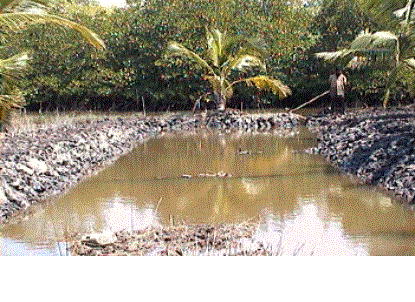
Crab culture in ponds
(Source: NIOT, Chennai)
Pen culture in Ponds
Several units of pens of 4 X 4 X 2.5 m could be made inside the ponds using bamboo
strips which are driven 1-1.5 m deep into the soil to prevent the escape of the
crabs by burrowing. The pens could be made nearer to the dykes for easy stocking
and monitoring.
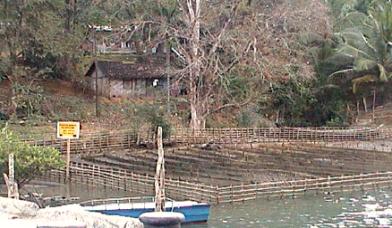
Crab culture in pens
(Source: NIOT, Chennai)
Pond culture in Mangrove
areas
The ponds could be constructed as described above around the mangrove plants. But
a maximum pond area of 100 m2 is suitable for this type of culture. A
canal of 1 m wide and 0.5 m deep, in which water will be available even during low
tide, should be dug around the edge of the pond. The centre of the pond forms a
raised platform with mangrove vegetation, which the crabs would use as a refuge
during low tide. Water exchange could be tidally controlled. Polythene nettings
could be used to prevent the escape of the crabs. Feeding depends on the availability
of organisms namely low-value fishes, mangrove snails, clams, mussels etc.
Pen culture in mangrove
areas
The pens could be constructed using the locally available bamboo splits or arecanut
logs or cane. These strips should be driven 1-1.5 m deep into the soil to keep the
crabs inside and the potential predators outside. The manageable area of the pen
could be 100 to 150 m2. With in the pen, a ditch of about 0.3 to 0.9
m wide and 0.3 m deep should be dug. Mangrove trees in the centre of the pen provide
shade for the crabs. Roughly 1000 to 1500 crabs of 100 g each could be stocked per
pen. The stocking should be continuous.
The crab could be fed once a day during high tide with low-cost fishes, mussels,
clams, snails etc. The crabs could be harvested after 4–7 months. The crabs
could be selectively harvested after they reach 400 g or more. Although this system
is eco-friendly, survival rate of only 47 to 50 % could be expected. The loss could
be mainly due to cannibalism, and escape of crabs. Lower stocking density is suggested
to be a remedy for the low survival rate.

Pond culture of crabs in mangrove areas
Cage culture (suspended
or fixed type)
Cage design
Crab fattening can be carried out in Cell-type Cane Cages
of 1 m (L) X 1 m (W) X 20 cm (H) size, which can be partitioned into nine equal
compartments. Each of these cages should be provided with a lid to prevent the escape
of crabs. A gap of 5 mm is to be provided between the canes at the top and 2.5 cm
at the sides of the cages to enable free movement of water through the cages. But,
no gap should be provided at the bottom to enable easy movement of the crabs.
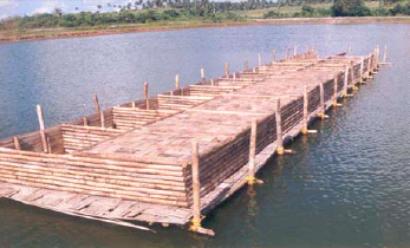
Crab culture in cages
(Source: NIOT, Chennai)
Stocking and feeding in cages
One crab should be placed in each compartment of the cages. In this method of fattening,
higher number of crabs can be fattened in a square meter area, i.e. 9 crabs/m2
. Based on the local availability, different types of feeds such as trash fish,
mussel, chicken waste, clams etc. can be given to the crabs.
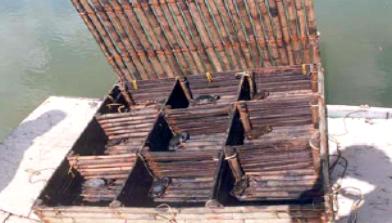
Crabs stocked in individual cages
(Source: NIOT, Chennai)
Deployment of cages
These cages can either be suspended from a raft deployed in bays or backwaters or
mangrove areas. These cages could also be made as a fixed type in ponds, mangrove
areas or coastal regions of the bays. The cages could be made without cells inside.
But the survival would reduce in this method due to cannibalism.
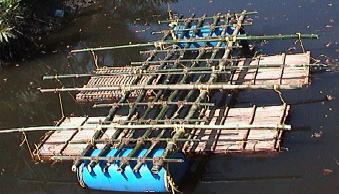
Deployment of cages
(Source: NIOT, Chennai)
Cage maintenance
- Clean the cages as frequently as possible using brushes enabling free movement of
water inside
- If nails are used in the cages, use only the anodized MS/ copper / SS nails for
increased longevity of cages in seawater.
- Repair the damages in the cages immediately when it happens
- Deploy the cages where there is mild water current
- If algal growth is found on the crabs, clean them using a brush.
Top
|